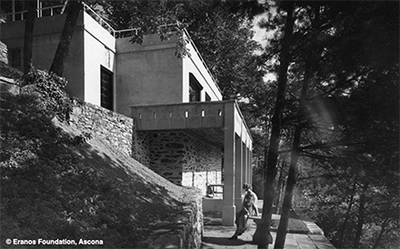ARAS Connections: Image and Archetype - 2020 Issue 4

The New Year is traditionally a time of renewal. Perhaps New Year’s 2021 is a particularly poignant and ripe time for renewal. It is our hope that Democracy itself will rediscover its foundations and that our nation’s and the world’s health will also begin to recover from the pandemic. We wish for all people—especially those who have been traditionally marginalized and discounted—that this is a time of profound renewal. Speaking of renewal: this is our 60th edition of ARAS Connections. I don’t think we imagined getting to 60 when we started 15 years ago, any more than most of us imagine getting older when we are young.
Synchronistically, this edition of ARAS Connections is also focused on renewal in the form of a return to our origins. In remembering our beginnings, we find focus on the three remarkable, pioneering women who gave birth to Eranos, the Bollingen Foundation, and ARAS: Olga Fröbe-Kapteyn, Mary Conover Mellon, and Jessie Fraser. The articles by Ami Ronnberg, Riccardo Bernardini, and Fabio Merlini take us on an amazing journey that spans much of the 20th century. Their papers in this edition of ARAS Connections are among the many fine contributions from Art and Psyche over the years. Ami has served on the steering group of Art and Psyche since its beginning in 2008 and has had a long and distinguished career as the Curator of ARAS, overseeing the publication of several books including The Book of Symbols.
We are especially pleased to welcome the contributions of Riccardo Bernardini, Scientific Secretary of the Eranos Foundation, and Fabio Merlini, President of the Eranos Foundation to ARAS Connections. Eranos is at the headwaters of ARAS and in that sense is the older sibling of ARAS. Bernardini and Merlini bring further focus to the extraordinary life trajectory of one of the three founding women, Olga Fröbe-Kapteyn who single-handedly created Eranos. Her relationship to the psyche and to C.G. Jung are at the very source of ARAS. ARAS Connections exists because of Olga Fröbe-Kapteyn, Mary Conover Mellon, and Jessie Fraser.
The Story of the Three Women Who Created ARAS

ARAS, The Archive for Research in Archetypal Symbolism has a long history, reaching back to the early 1930s in Switzerland. Many known and unknown contributors have been part of making ARAS what it is today, a national organization with centers in New York City, San Francisco, Los Angeles, Chicago, as well as ARAS Online, serving visitors from many other countries. But it all began with three remarkable women who dedicated their lives to exploring the transformations of the psyche – and creating an actual place to do this, each in her own way.
The time is the beginning of the 20th century when we first meet Olga-Froebe- Kapteyn, the first woman of the ARAS lineage. Olga (I hope she and the other women would allow me to use their first names) – Olga was born in 1881 in London. Her parents were Dutch. Her father Albert Kapteyn was an inventor, a photographer and director of Westinghouse London office. Her mother was a writer on social issues and a friend of George Bernard Shaw. And according to Paul Mellon, who wrote about Olga in his autobiography Born with a Silver Spoon, Olga once joined a circus, which might help explain the more adventurous side of her.
As a young woman, Olga went to Zurich to study applied art. It seems that she was interested in art and images from the very beginning. There she met Irwin Froebe, who was a musician from Austria. Olga was only 27 years old when her husband died, following an airplane crash, during the first world war. Some years later, Olga and her father went on vacation to Ascona, a small city south of the Alps in the Italian-speaking area of Switzerland. Olga fell in love with the area, and her father bought for her Casa Gabriela, a villa on a beautiful piece of land overlooking Lake Maggiore.
The stage was set for what was going to become a remarkable meeting place for people and ideas. But it began with seven years of solitude in which Olga lived in Casa Gabriela completely isolated except for a servant. She was studying metaphysics, and she was particularly interested in Eastern mysticism. She came across the I Ching, which was to have a great impact on her and later she met Richard Wilhelm, its translator. He was the first of three men who were to be very influential in her life. Through the I Ching, she found an ancient Chinese system that spoke to her as a method of aligning one’s inner nature with the outer world and of knowing what is the right way at a particular moment. In this way, hidden patterns are revealed, making the invisible world visible. This was to be a motif throughout Olga’s life.
Read The Story of the Three Women who created ARAS in its entirety here.
Olga Fröbe-Kapteyn (1881–1962): A Woman’s Individuation Process through Images at the Origins of the Eranos Conferences

More than eighty-five years have passed since the founding of the Eranos Conferences (Eranos Tagungen) in 1933. This pioneering endeavor of interdisciplinary gatherings, which has been properly recognized as “one of the most creative cultural experiences in the modern Western world” and “one of the richest centers of intellectual and spiritual interchange known to our century,” was promoted in Ascona (Switzerland) by Olga Fröbe-Kapteyn (1881–1962).
In the case of Carl Gustav Jung (1875–1961), who was among the main inspirers of Eranos since the early ‘30s, the publication of The Red Book helped to realize all the more the strict connection between his personal and his intellectual paths. Up to now, several of Olga Fröbe-Kapteyn’s allusions have sounded much more hermetic. For example, she stated, “The deepest things in human life … can only be expressed in images.” Or: “I beg your pardon if I am speaking through images! This is the way my mind works.” These are words that become much clearer now in the light of her artworks, which can be conceptually and temporally situated in two periods: a first series of “Meditation Plates,” created between 1926 and 1934, and in particular during the period of her collaboration with esotericist and theosophist Alice Ann Bailey (1880–1949); and a second series of “Visions”: an outstanding collection of over three-hundred paintings that were realized – with the Jungian technique of the active imagination – between 1934 and 1938. These were the crucial years of the beginning of Olga Fröbe-Kapteyn’s cultural enterprise, her longstanding relationship with Jung, and her research into iconographic material entrusted to her by Jung, which led to the creation of the Eranos Archive for Research in Symbolism.
Olga Fröbe-Kapteyn was born in London of Dutch parents, from a culturally rich background, on October 19, 1881. Her father, Albertus Philippus Kapteyn (or Kapteijn, 1848–1927), was director and later vice-president of the Westinghouse Brake & Signal Company in London. Her mother, Geertruida (Truus) Agneta Kapteyn-Muysken (1855–1920), was involved in women’s emancipation and social renewal movements. Olga Fröbe-Kapteyn was the eldest of three children. Her interest in art can be traced back to the fascination she experienced in her childhood, when her father, a passionate photographer, in their home in London, developed photographic films in the darkroom under the curious eyes of his little daughter.
In 1900, Olga Fröbe-Kapteyn moved to Zurich with her father. There she attended the “School of Applied Arts,” excelling in tailoring, embroidery, and jewelry. From 1906 to 1909, she continued his education in art history at the University of Zurich. In 1909, she married the orchestra conductor, Iwan Fröbe (1880–1915), with whom she lived in Munich, Berlin, Gersau am Vierwaldstättersee, and then, from December 1914, in Zurich again. In Berlin, she had attended a sewing club, “The Needle,” founded by art historian André Jolles (1874–1946); her silk blouse with colored embroidery was exhibited in 1916 as part of a textile exhibition at the Museum of Applied Arts in Zurich.
Widowed in September 1915, Olga Fröbe-Kapteyn ran her own cultural club in Zurich. In 1919–1920, she moved to the South of Switzerland, to take advantage of some natural treatments at the famous Sanatorium Monte Verità in Ascona. In those years, in Europe, many movements of “reform of life” inspired by the East were born, among which Monte Verità (“Mountain of Truth”) was one of the most striking and fortunate examples. It is in this context that the psychoanalyst, anarchist, and revolutionary Otto Gross (1877–1920) between 1905 and 1911, had planned to create the prototype of an ideal matriarchal society. In love with the beauty of the place, in 1920, Olga Fröbe-Kapteyn settled down in the charming Casa Gabriella in Ascona-Moscia, on the shores of Lake Maggiore. It was there that during a long period of solitary “concentration discipline” (Konzentrationsdiszipline), which lasted seven years, she familiarized herself with oriental philosophies, esotericism, and meditation.
Read Olga Fröbe-Kapteyn (1881–1962): A Woman’s Individuation Process through Images at the Origins of the Eranos Conferences in its entirety here.
Contents
Become a Member of ARAS!
Become a member of ARAS Online and you'll receive free, unlimited use of the entire archive of 17,000 images and 20,000 pages of commentary any time you wish—at home, in your office, or wherever you take your computer.
The entire contents of three magnificent ARAS books: An Encyclopedia of Archetypal Symbolism, The Body and The Book of Symbols are included in the archive. These books cost $330 when purchased on their own.
You can join ARAS Online instantly and search the archive immediately. If you have questions, please call (212) 697-3480 or email info@aras.org
We Value Your Ideas
As our newsletter grows to cover both the ARAS archive and the broad world of art and psyche, we're eager to have your suggestions and thoughts on how to improve it. Please send your comments to info@aras.org. We look forward to your input and will reply to every message.
Subscribe
If you're not already a subscriber and would like to receive subsequent issues of this newsletter by email at no cost, e-mail us at newsletter@aras.org.
